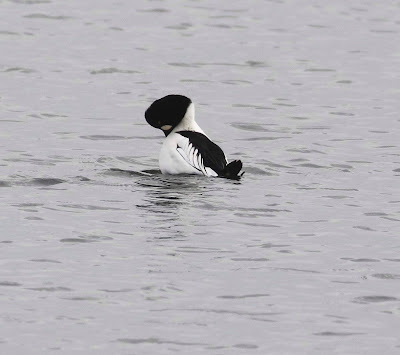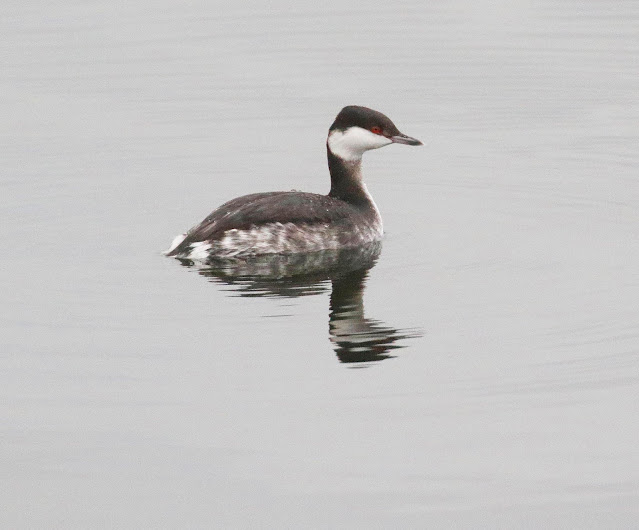This is another form of birding I like. A pleasant, relaxed and refreshing counterpoint to twitching and hurtling off to some far flung destination at a moment's notice, to see a rare bird, which I am prone to do and, I should add, still enjoy.
We set off up the central causeway and soon found the Slavonian Grebe, out on the deeper, open water half way along the larger basin, its small elegant form a pinprick on the vast expanse of still water. A party of Goldeneye swam out from the edge of the causeway, a drake and four females, then lifted off the smaller basin with audibly whirring wings and flew over the causeway to land on the larger basin, possibly feeling more secure there.
We visited the hide at Pinkhill and admired a dozen Common Snipe, hunkered down at the base of the reeds on the far side of the marsh. Some slept whilst others preened or just stood in the water, their elongated bills inclined downwards, resting on their breasts, the cryptic, barred and stripey patterning of buff, cream and darker brown plumage merging with the dead reeds so, unless the birds moved, they became almost as one with the reeds.
Leaving the hide we walked up the bank of the smaller reservoir to regain the perimeter track.The plan was to walk all the way around the reservoir but there was no birdlife visible so we turned to head back to the causeway, checking a small flock of Tufted Duck to see if the two Greater Scaup were amongst them. There was no sign of the scaup but a male Goldeneye amongst the Tufted Ducks caught our attention as it was behaving oddly. It looked to be in some trouble and was constantly treading water whilst pulling at the feathers on its lower breast. We watched it for some time and it never ceased standing in the water and frantically preening. It was not possible to discern the problem but I could see a dark mark on its normally pure white breast but the distance was too far to be sure of what it was. I could only speculate that the unfortunate duck had maybe got some fishing line caught around it or even worse a hook embedded in its breast.
I have found discarded fishing line at the reservoir before and occasionally hooks attached to line too, that has presumably broken off in the water or even been wilfully discarded. Something was certainly irritating the duck and making it almost frantic in trying to rectify whatever was wrong. It could not be rescued by boat as it was still capable of flight so reluctantly we had to leave it to its fate.
Commencing the return walk along the causeway I found the Slavonian Grebe had moved to its customary, favourite, sheltered northwest corner on the larger basin and was now close enough, despite the dull light to justify another attempt at photography. This confiding grebe must currently be the most photographed bird in Oxfordshire with a constant procession of photographers and or birders coming to see and admire it, and why not. It is not often one stays for such an extended period and allows one to get so close to it.
The others walked on, chatting but I decided to tarry a while to watch and photograph the grebe, the water so calm that sometimes only the ripples from the grebe's movements, corrugated its perfect reflection.
I reluctantly left the grebe, a rotund buoyant sphere of grey, white and black feathers sitting on the water, its silhouette defined with a precision that can only come on a day of total calm such as this. So still was it, that when the grebe surfaced, drops of water like tiny glass beads remained adhered to its head, bill and upperbody.
I reluctantly left the grebe, a rotund buoyant sphere of grey, white and black feathers sitting on the water, its silhouette defined with a precision that can only come on a day of total calm such as this. So still was it, that when the grebe surfaced, drops of water like tiny glass beads remained adhered to its head, bill and upperbody.
Further down the causeway a group of Tufted Ducks and Coots were feeding very close to the shelving concrete apron that skirts each side of the causeway. A closer inspection revealed that amongst this diving throng were six Goldeneye, two drakes and four females.They were immediately distinctive amongst the smaller Tufted Ducks, due to their large, dark, almost triangular shaped heads and the drake's striking black and white plumage, making identification unmistakeable
It is unusual for Goldeneye to allow a close approach but these seemed content, so long as the Tufted Ducks and Coots showed no alarm. This was too good an opportunity to miss and so, using a convenient lifebuoy mounted on a pole to partially conceal my profile, I managed to get very close indeed.
 |
| Male Goldeneye |
 |
| Female Goldeneye |
What a marvellous thing it is to witness such a display. It feels almost a privilege to watch this un-selfconcious outburst of unalloyed passion, drawing one into a world and existence that is beyond ours. I confess to finding a measure of solace in watching birds such as this going about their natural lives, a re-assuring affirmation that there is order in this world and a perfect distraction from these troubled times
I walked onwards back to the cafe where a bowl of lunchtime soup and the others awaited me.
My mind wandered to speculate on the origin of these Goldeneye and why there are always more females than males in the small groups that arrive at Farmoor. The latter question I do not have the answer to but their origin can be anywhere from the north of Scotland where they breed in small but increasing numbers to the major breeding areas of Scandinavia, the Baltic States and northern Russia.
Goldeneyes normally breed in natural cavities in trees. In northern Scotland they first bred in 1970 at Loch an Eilan in Badenoch but the population was constrained due to a lack of suitable sized nest cavities in the trees. This was thought to be due to Britain not having a native population of the large Black Woodpecker which excavate holes that are suitable in size for the Goldeneyes to nest in, the ducks making use of any disused or abandoned woodpecker nest holes. However a scheme was launched to erect specially constructed tree mounted nest boxes, with suitable sized holes, near lochs on Speyside in northern Scotland and this has been a great success, so much so that the number of breeding pairs in Scotland had reached a hundred by the year 2000 and currently is double that figure, with random breeding records from Northumberland and even Chew Valley in Somerset.
My mind wandered to speculate on the origin of these Goldeneye and why there are always more females than males in the small groups that arrive at Farmoor. The latter question I do not have the answer to but their origin can be anywhere from the north of Scotland where they breed in small but increasing numbers to the major breeding areas of Scandinavia, the Baltic States and northern Russia.
Goldeneyes normally breed in natural cavities in trees. In northern Scotland they first bred in 1970 at Loch an Eilan in Badenoch but the population was constrained due to a lack of suitable sized nest cavities in the trees. This was thought to be due to Britain not having a native population of the large Black Woodpecker which excavate holes that are suitable in size for the Goldeneyes to nest in, the ducks making use of any disused or abandoned woodpecker nest holes. However a scheme was launched to erect specially constructed tree mounted nest boxes, with suitable sized holes, near lochs on Speyside in northern Scotland and this has been a great success, so much so that the number of breeding pairs in Scotland had reached a hundred by the year 2000 and currently is double that figure, with random breeding records from Northumberland and even Chew Valley in Somerset.
In winter in Britain, Goldeneyes can be found on suitable large lakes, reservoirs such as Farmoor, large rivers, estuaries and around the coast. Approximately 27,000 Goldeneye winter in Britain mainly in Scotland and northern England. Many more, up to 250,000 winter around the coast of Denmark and the Baltic Sea. In Oxfordshire only small numbers spend the winter, often to be found on Farmoor, where they rarely exceed single figures and on the nearby Dix Pit at Stanton Harcourt where numbers can sometimes reach double figures.
Most Goldeneye arrive in Oxfordshire in November or December and depart in February or March which is a similar pattern to the birds wintering in other parts of Britain.
It is a thrill to note their arrival on the reservoir and I always look forward to finding them, a highlight on my winter visits when birding can be tough going.
















No comments:
Post a Comment